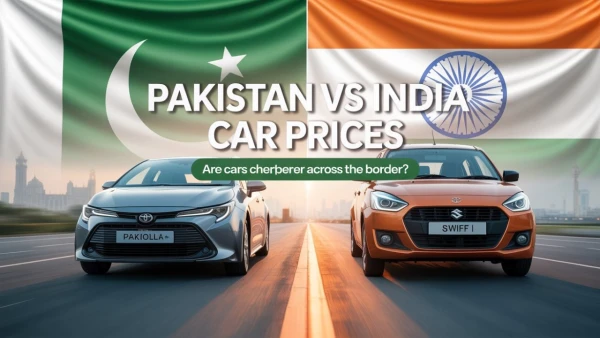
- Admin
- Aug 22, 2025
- latest updates
Pakistan vs India Car Prices (2025) - Detailed Comparison.
Affordability is one of the first things that buyers look at when deciding to purchase a car. In the South Asian region, especially Pakistan and India, the topic of car prices has become a debated subject among car freaks and common people.
The most often asked question is, are cars cheaper in India or Pakistan? The simple answer to the question is-- yes, the cars are normally cheaper in India.
However, the reasons are much further than exchange rates alone. Let us have a closer examination of Pakistan vs India car prices in rupees and analyze why we frequently find automobiles on the other side of the border to be cheaper.
The Market Size Difference
The size of the automotive market in India and Pakistan is one of the major factors contributing to the existence of a price gap in the automotive industry in both countries.
-
India: India has an automobile market of the fourth largest in the world, with millions of vehicles sold in a year. This enormous demand enables the manufacturers to experience economies of scale, namely that the more units delivered, the lower the cost per unit.
-
Pakistan: The market in comparison is still much smaller in Pakistan. The volume of annual sales is typically less than 300,000 vehicles, which is insignificant in comparison with India. Due to this reduced scale, however, the cost of production of cars in each car is very high, and so manufacturers cannot afford to give car buyers large rebates.
In simpler terms, the cost of purchasing the car is lower in India due to the volumes of the car manufactured and sold.
Local Manufacturing and Localization
Local manufacturing is another key element in the India vs Pakistan car price comparison.
-
India: The Indian automotive industry is an advanced one, with global giants such as Suzuki, Hyundai, Toyota, Honda, Kia, and Tata producing automobiles in India. Much of its production is in America: from engines to transmissions. The localization is at this high level to keep the cost low.
-
Pakistan: Pakistan has bridged the gap in its motorcycle and tractor manufacturing, but there is still a great reliance on imported components in its car manufacturing industry. Local assembly is present, but localization levels are far lower than those of India. Foreign components are more expensive in terms of customs fees, transportation, and exchange rates.
One of the reasons why the Pakistan vs India car prices differ so widely is this dependence on imports.
Taxation and Government Policies
Taxes play a massive role in determining whether cars are cheaper in India or Pakistan.
-
India: Although cars in India are taxed under the Goods and Services Tax (GST), the rates are comparatively lower than Pakistan’s import duties and registration fees. India also offers incentives for electric and small cars, further making them affordable for the middle class.
-
Pakistan: Pakistan imposes heavy import duties, sales tax, excise duty, and other regulatory charges on vehicles. Even locally assembled cars face high taxation, making the final retail price significantly higher. Government policies are often designed to protect local assemblers, but in practice, they make cars unaffordable for ordinary buyers.
Currency Exchange Rates
Currency fluctuations also play a role in the Pakistan vs India car prices in rupees comparison.
-
India’s Rupee (INR): The Indian rupee is relatively more stable against the US dollar. This stability helps maintain predictable car pricing.
-
Pakistan’s Rupee (PKR): The Pakistani rupee has faced steep devaluation in recent years. Since many car parts are imported in dollars, every time the PKR weakens, car prices shoot up.
As a result, even if the base price of a car is similar, Pakistani buyers end up paying significantly more due to currency-related inflation.
Specific Car Price Comparisons
To make the India vs Pakistan car price comparison more concrete, let’s look at popular models (prices in rupees, approximate 2025 figures):
|
Car Model |
Price in Pakistan |
Price in India (INR) |
Converted Price (PKR) |
Which is Cheaper? |
|
Suzuki Alto |
PKR 23–32 lakhs |
INR 4.2–6.8 lakhs |
PKR 15–26 lakhs |
India |
|
Toyota Yaris |
PKR 23–32 lakhs |
INR 9–15 lakhs |
PKR 33–55 lakhs |
India (mostly) |
|
Honda City |
PKR 46–58 lakhs |
INR 12–17 lakhs |
PKR 44–62 lakhs |
Comparable (India has better features) |
|
Hyundai Tucson |
PKR 90 lakhs – 1.1 crore |
INR 29–35 lakhs |
PKR 105–126 lakhs |
Pakistan (slightly) |
These comparisons show that while most small and mid-sized cars are cheaper in India, some SUVs and premium models may cost similar or even more in India.
Consumer Purchasing Power
It’s not just about the sticker price; it’s also about affordability.
-
India: With a higher per capita income and a larger middle class, more families can afford cars. Financing and loan options are also more accessible.
-
Pakistan: Car financing is expensive, and rising inflation has squeezed the purchasing power of middle-class buyers. Even small cars are often out of reach for average households.
This creates a perception that cars in Pakistan are overpriced compared to India, even when some models overlap in cost.
Future Outlook
The gap in car prices in India vs Pakistan may widen or shrink depending on government policies and industry reforms.
-
If Pakistan increases localization and stabilizes its currency, prices may come down in the long run.
-
India, with its booming EV sector and growing exports, is expected to maintain its position as a cheaper and more competitive car market.
Until then, the reality is that for the average buyer comparing Pakistan vs India car prices in rupees, cars across the border remain more affordable.
Conclusion
So, are cars cheaper in India or Pakistan? For the most part, India wins the comparison. Due to its larger market, advanced local manufacturing, favorable taxation, and a relatively stable currency, India offers cars at prices that are significantly lower than those in Pakistan.
For Pakistani consumers, this often feels unfair, especially when both countries share similar brands and models. However, unless Pakistan expands its local auto industry, reduces taxes, and stabilizes its currency, the Pakistan vs India car prices debate will continue to tilt in India’s favor.
In the end, while both nations are neighbors, their car markets tell two very different stories, one of scale and affordability, and the other of high costs and limited choices.


Comments